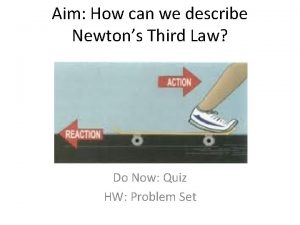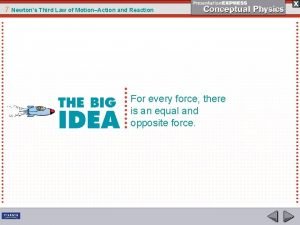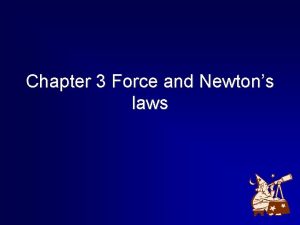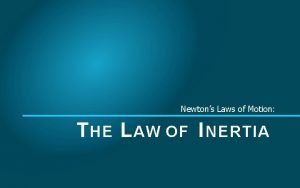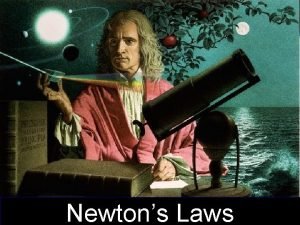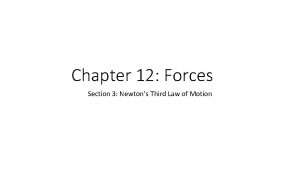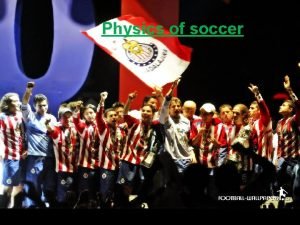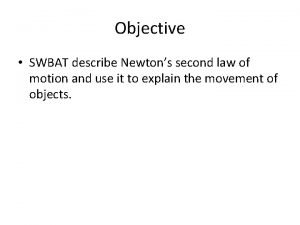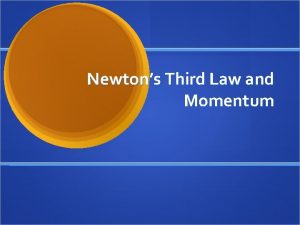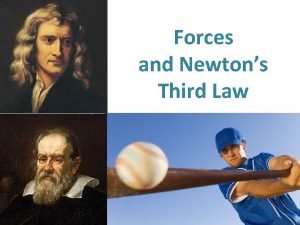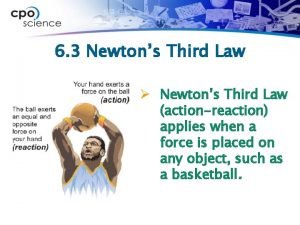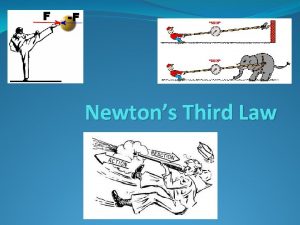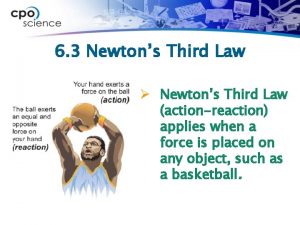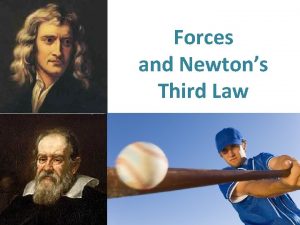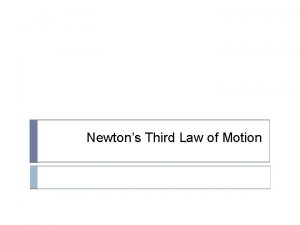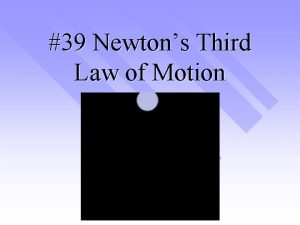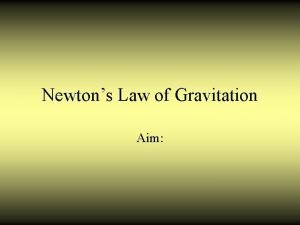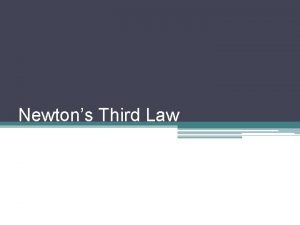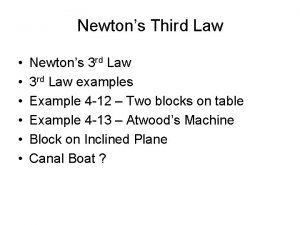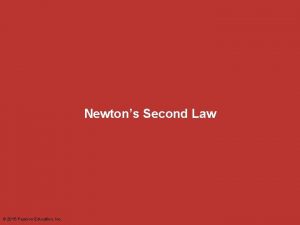Section 4 7 Newtons Third Law 2015 Pearson


















- Slides: 18

Section 4. 7 Newton’s Third Law © 2015 Pearson Education, Inc.

Newton’s Third Law • Motion often involves two or more objects interacting with each other. • As the hammer hits the nail, the nail pushes back on the hammer. • A bat and a ball, your foot and a soccer ball, and the earth-moon system are other examples of interacting objects. © 2015 Pearson Education, Inc. Slide 4 -2

Interacting Objects • An interaction is the mutual influence of two objects on each other. • The pair of forces shown in the figure is called an action/reaction pair. • An action/reaction pair of forces exists as a pair, or not at all. © 2015 Pearson Education, Inc. Slide 4 -3

Reasoning with Newton’s Third Law © 2015 Pearson Education, Inc. Slide 4 -4

Runners and Tires • In order for you to walk, the floor needs to have friction so that your foot sticks to the floor as you straighten your leg, moving your body forward. • The friction that prevents slipping is static friction. • The static friction has to point in the forward direction to prevent your foot from slipping. © 2015 Pearson Education, Inc. Slide 4 -5

Rockets • The rocket pushes hot gases out the back, and this results in a forward force (thrust) on the rocket. © 2015 Pearson Education, Inc. Slide 4 -6

Quick. Check 4. 16 10 -year-old Sarah stands on a skateboard. Her older brother Jack starts pushing her backward and she starts speeding up. The magnitude of the force of Jack on Sarah is A. Greater than the magnitude of the force of Sarah on Jack. B. Equal to the magnitude of the force of Sarah on Jack. C. Less than the magnitude of the force of Sarah on Jack. © 2015 Pearson Education, Inc. Slide 4 -7

Quick. Check 4. 16 10 -year-old Sarah stands on a skateboard. Her older brother Jack starts pushing her backward and she starts speeding up. The force of Jack on Sarah is A. Greater than the magnitude of the force of Sarah on Jack. B. Equal to the magnitude of the force of Sarah on Jack. C. Less than the magnitude of the force of Sarah on Jack. © 2015 Pearson Education, Inc. Slide 4 -8

Quick. Check 4. 17 A mosquito runs head-on into a truck. Splat! Which is true during the collision? A. The mosquito exerts more force on the truck than the truck exerts on the mosquito. B. The truck exerts more force on the mosquito than the mosquito exerts on the truck. C. The mosquito exerts the same force on the truck as the truck exerts on the mosquito. D. The truck exerts a force on the mosquito but the mosquito does not exert a force on the truck. E. The mosquito exerts a force on the truck but the truck does not exert a force on the mosquito. © 2015 Pearson Education, Inc. Slide 4 -9

Quick. Check 4. 17 A mosquito runs head-on into a truck. Splat! Which is true during the collision? A. The mosquito exerts more force on the truck than the truck exerts on the mosquito. B. The truck exerts more force on the mosquito than the mosquito exerts on the truck. C. The mosquito exerts the same force on the truck as the truck exerts on the mosquito. D. The truck exerts a force on the mosquito but the mosquito does not exert a force on the truck. E. The mosquito exerts a force on the truck but the truck does not exert a force on the mosquito. © 2015 Pearson Education, Inc. Slide 4 -10

Example Problem Squid use jet propulsion for rapid escapes. A squid pulls water into its body and then rapidly ejects the water backward to propel itself forward. A 1. 5 kg squid (not including water mass) can accelerate at 20. m/s 2 by ejecting 0. 15 kg of water. A. What is the magnitude of the thrust force on the squid? B. What is the magnitude of the force on the water being ejected? C. What acceleration is experienced by the water? © 2015 Pearson Education, Inc. Slide 4 -11

Summary: General Principles Text: p. 118 © 2015 Pearson Education, Inc. Slide 4 -12

Summary: General Principles © 2015 Pearson Education, Inc. Text: p. 118 Slide 4 -13

Summary: Important Concepts Text: p. 118 © 2015 Pearson Education, Inc. Slide 4 -14

Summary: General Principles Text: p. 118 © 2015 Pearson Education, Inc. Slide 4 -15

Looking Back – Chapter 3 problems © 2015 Pearson Education, Inc.

Example Problem • Small plane pilots regularly compete in “message drop” competitions, dropping heavy weights (for which air resistance can be ignored) from their low-flying planes and scoring points for having weights land close to a target on the ground. A plane 60. m above the ground is flying horizontally toward a target at 45 m/s. A. At what distance from the target should the pilot drop the weight? B. What is the magnitude and direction of the vector which points from the target to the plane at the instant the weight hits the target? © 2015 Pearson Education, Inc. Slide 4 -17

Example Problem • The gulf stream off the east coast of the U. S. can flow at a rapid 3. 6 m/s to the north. A ship in the current has a cruising speed of 10. m/s. A captain would like to reach land a point directly due west of his current position. A. In what direction should the ship head? B. At this heading, what is the ship’s speed with respect to land? © 2015 Pearson Education, Inc. Slide 4 -18
 Describe newtons third law
Describe newtons third law Newton's third law of thermodynamics
Newton's third law of thermodynamics Third
Third Newtons third law
Newtons third law Newton's third law
Newton's third law Newton first law
Newton first law Newton's first law and second law and third law
Newton's first law and second law and third law Newton's first law and second law and third law
Newton's first law and second law and third law Section 3 using newtons law
Section 3 using newtons law What are newton's 3 laws
What are newton's 3 laws Newtons aw
Newtons aw Newton's third law of motion is also known as the law of
Newton's third law of motion is also known as the law of Chapter 12 section 3 newton's third law answer key
Chapter 12 section 3 newton's third law answer key Gj mount classification
Gj mount classification Odontoclasia definition
Odontoclasia definition Newtons 3 rd law of motion
Newtons 3 rd law of motion Physics
Physics Describe newtons second law
Describe newtons second law Example of first law of motion
Example of first law of motion
